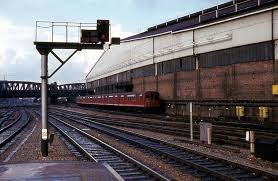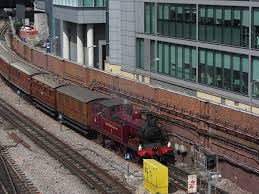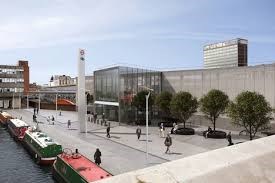The Hammersmith & City line

This London Underground runs between Hammersmith and Barking. Coloured salmon pink on the tube map, it serves 29 stations in 15.8 miles (25.5 km). It is underground in the central section between Paddington and Bow Road; between Farringdon and Aldgate East it skirts the City of London, the capital's financial heart. The tunnels are just below the surface and are a similar size to those on British main lines. Most of the track and all stations are shared with the District, Circle or Metropolitan lines, the other parts of London Underground's sub-surface railway, and over 114 million passenger journeys are made each year on this line and the Circle line.

In 1863 the Metropolitan Railway began the world's first underground railway service between Paddington and Farringdon with wooden carriages and steam locomotives. The following year a railway west from Paddington to Hammersmith opened and this soon became operated and owned jointly by the Metropolitan and Great Western railways. The line was extended to the east in stages, reaching the East London Railway in 1884. The line was electrified in 1906, and in 1936, after the Metropolitan Railway had been absorbed by London Passenger Transport Board, some Hammersmith & City trains were extended over the former District Railway line to Barking. The Hammersmith & City route was shown on the tube map as part of the Metropolitan line until 1990, when it appeared as a separate line.
The track and signalling systems are being upgraded and the old 6-car C Stock trains have been replaced by new 7-car S Stock trains in a programme to increase capacity by 65 per cent by 2019.
The line runs parallel to the Great Western Main Line between Paddington and Westbourne Park and parallel to the London, Tilbury and Southend Railway between West Ham and Barking.
The first line built by the Metropolitan Railway (Met) was from Paddington to near Smithfield, near London's financial heart in the City; with gas-lit wooden carriages hauled by steam locomotives opened on 10 January 1863 it was the world's first underground railway. The line was built mostly under the New Road using the "cut-and-cover" method between Paddington and King's Cross and then in tunnel and cuttings beside Farringdon Road. Supported by the Met and the Great Western Railway (GWR), the Hammersmith & City Railway (H&CR) was built from the GWR's main line a mile west of Paddington station to the developing suburbs of Shepherd's Bush and Hammersmith. Built on viaduct largely across open fields, the line opened on 13 June 1864 with a GWR service from Farringdon to Hammersmith, services to Addison Road (now Kensington (Olympia)) on the West London Railway via a link at Latimer Road starting a few weeks later. From 1865 the Met ran trains to Hammersmith and the GWR trains to Addison Road. In 1867 the line became jointly owned by the two companies. In 1871 two additional tracks parallel to the GWR between Westbourne Park and Paddington were brought into use for the H&CR, and in 1878 the flat crossing at Westbourne Park was replaced by a dive-under. A year earlier some services had been extended via London & South Western Railway's Hammersmith (Grove Road) railway station and their line to Richmond.

The railway was extended east of Farringdon and a terminus opened at Aldgate on 18 November 1876. The Met wished to access the South Eastern Railway via the East London Railway (ELR) and jointly with the District Railway built lines from their Mansion House station to the Met's Aldgate station and east from Aldgate to reach the ELR at Whitechapel. In October 1884 the Met extended some Hammersmith services over the ELR to New Cross.
In 1902 the Whitechapel & Bow Railway was opened, linking the District Railway at Whitechapel to the London, Tilbury and Southend Railway (LT&SR) at an above-ground junction at Bow, to the west of Bromley-by-Bow station, and some District services were extended from Whitechapel to East Ham. When the line was electrified in 1906 services to Richmond were withdrawn and the western termini became Hammersmith and Kensington (Addison Road), and to the east services were diverted from the ELR to Whitechapel, until the ELR was electrified in 1914 and services ran from Hammersmith to New Cross and New Cross Gate. The 6-car electric multiple units were jointly owned by the Met and GWR until 1923 when the GWR sold theirs to the Met.
On 1 July 1933 the Metropolitan Railway was amalgamated with other Underground railways, tramway companies and bus operators to form the London Passenger Transport Board. To relieve congestion on the District line east of Whitechapel from 1936 some trains from Hammersmith were diverted from the East London line to Barking. Through trains to New Cross and New Cross Gate were withdrawn in November 1939, the Hammersmith & City line trains terminating at Whitechapel while the longer 8-car Uxbridge line trains ran to Barking. However, this caused operational problems and from 1941 Barking was again served by trains from Hammersmith.

From 1937 new steel O stock trains, with doors remotely operated by the guard, replaced the wooden-bodied trains dating from 1906. It had been intended to operate the new trains with four or six cars, but after initial problems with the traction current only six-car formations were used. Services to Kensington (Olympia) via the curve at Latimer Road were suspended in 1940 after bomb damage to the West London line and not restarted after the war. When the similar trains running on the Circle line were lengthened to six cars in 1959 and 1960, the stock of the two lines was integrated with maintenance at Hammersmith depot.Aluminium C Stock trains, with public address systems and originally unpainted, replaced these trains from 1970. One person operation was proposed in 1972, but due to conflict with the trade unions was not introduced until 1984.
Depot
The line's depot is at Hammersmith, close to Hammersmith station, built by the Great Western Railway to be operated by the Metropolitan Railway when the joint railway was electrified in the early 20th century.Sidings at Barking, Farringdon and near High Street Kensington (Triangle Sidings) stable trains overnight.